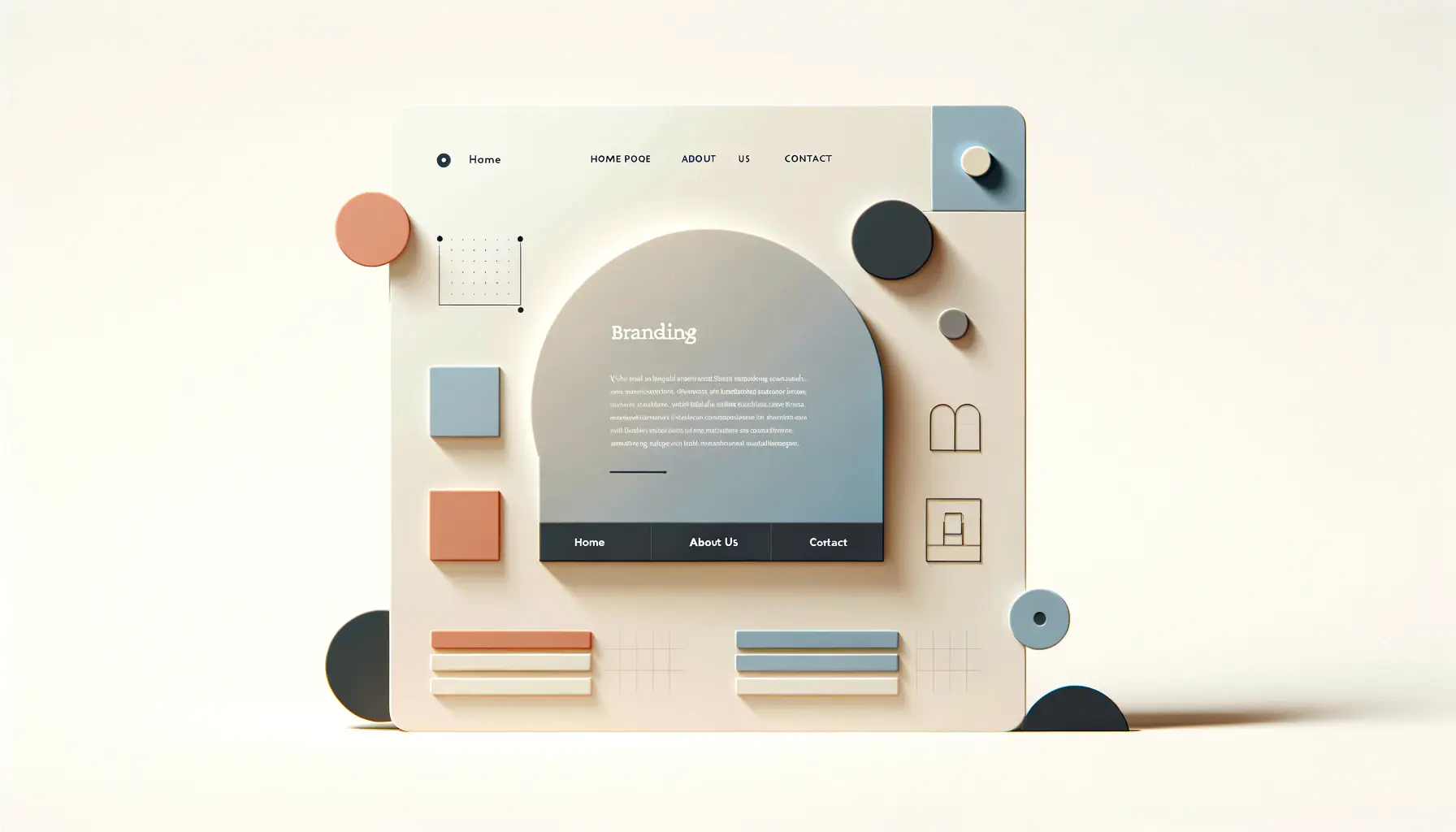Branding in web design is a critical aspect of establishing a business’s online presence.
It’s not just about creating a visually appealing website; it’s about conveying your brand’s identity, values, and message through every element on the page.
The process involves a strategic blend of graphic design, user experience (UX) design, content strategy, and digital marketing efforts.
As businesses strive to stand out in a crowded digital landscape, understanding the costs associated with branding in web design becomes essential for effective budgeting and planning.
Investing in branding is investing in the business’s future.
A well-branded website can significantly impact customer perception, engagement, and loyalty.
It serves as the digital face of the company, often being the first point of contact between the business and potential customers.
Therefore, allocating the right resources towards branding in web design is not an expense but a strategic investment that can yield substantial returns over time.
This article aims to explore the various facets of branding costs in web design, offering insights into budgeting essentials that businesses need to consider.
- Understanding Branding Costs in Web Design
- Strategic Planning and Its Impact on Budget
- Role of Design Elements in Branding
- Branding Through Social Media Integration
- Collaboration Between Design and Marketing Teams
- Incorporating Feedback in the Branding Process
- Emphasizing Sustainability in Branding
- Wrapping Up: The Essence of Branding in Web Design
- FAQs on the Costs of Branding in Web Design
Understanding Branding Costs in Web Design
Components of Branding in Web Design
Branding in web design encompasses several components, each contributing to the overall identity and perception of the brand online.
These components include logo design, color scheme, typography, imagery, and content.
A cohesive approach to these elements ensures that the website reflects the brand’s personality and values, creating a memorable experience for visitors.
The costs associated with these components can vary widely, depending on the complexity of the design, the expertise of the designers, and the specific goals of the branding strategy.
For instance, logo design can range from a few hundred to several thousand dollars, influenced by the designer’s skill level and the intricacy of the logo.
Similarly, the choice of typography and color scheme involves not just aesthetic considerations but also licensing fees for certain fonts and the creation of custom graphics.
These decisions, while seemingly minor, play a significant role in the branding process and can impact the overall budget.
Effective branding in web design is not just about aesthetics; it’s about creating a cohesive identity that resonates with the target audience.
Factors Influencing Branding Costs
The costs of branding in web design are influenced by several factors, including the scope of the project, the level of customization required, and the agency or designer’s expertise.
A larger, more complex website with custom graphics, animations, and interactive elements will naturally incur higher costs than a simpler site.
Additionally, the choice of a web design agency or freelancer can significantly affect the budget.
Agencies might offer comprehensive packages that cover all aspects of branding and design, while freelancers may charge less but require more direction and management.
Another critical factor is the level of research and strategy involved in the branding process.
Developing a deep understanding of the brand’s target audience, competitors, and market position requires time and resources but is essential for creating a website that effectively communicates the brand’s message.
This strategic foundation ensures that the website not only looks good but also performs well, engaging users and driving conversions.
Strategic Planning and Its Impact on Budget
Strategic planning forms the backbone of effective branding in web design, directly impacting the project’s budget.
This phase involves defining the brand’s goals, target audience, and competitive landscape.
A well-crafted strategy not only guides the design process but also ensures that every element of the website aligns with the brand’s objectives.
The depth of strategic planning required can significantly influence the overall costs, making it a crucial factor for businesses to consider during the budgeting phase.
Key components of strategic planning include:
- Brand discovery sessions
- Market research
- Competitor analysis
- User persona development
- Content strategy formulation
Investing in a thorough strategic planning process can lead to a more effective and impactful website, potentially saving costs in the long run by avoiding unnecessary revisions and ensuring that the site meets its intended goals from the outset.
Cost-Effective Strategies for Branding
While branding in web design is essential, it doesn’t have to break the bank.
Several cost-effective strategies can help businesses achieve a strong brand presence online without exceeding their budget.
These strategies include:
- Utilizing open-source tools and platforms
- Choosing pre-designed templates with customization options
- Employing a phased approach to web design and branding
- Leveraging existing brand assets and content
By adopting these strategies, businesses can manage the costs of branding more effectively, ensuring that they invest in areas that offer the highest return on investment.
It’s about being smart with the budget, focusing on elements that will significantly impact the brand’s online presence.
Incorporating cost-effective strategies doesn’t mean compromising on quality. It’s about maximizing resources to build a strong brand identity within budget constraints.
DIY Branding vs. Professional Services
Businesses often face the dilemma of choosing between DIY branding and hiring professional services.
While DIY branding can appear more budget-friendly, it comes with its own set of challenges, including the potential for a less professional outcome and the time investment required.
On the other hand, professional services, though initially more costly, bring expertise, efficiency, and a polished result that can significantly enhance the brand’s online presence.
Considerations for choosing between DIY and professional services include:
- The complexity of the branding requirements
- The available internal resources and expertise
- The long-term impact on the brand’s image and online performance
Ultimately, the decision should be based on a balance between budget constraints and the desired quality and effectiveness of the branding effort.
Role of Design Elements in Branding
The visual components of a website play a pivotal role in branding, directly influencing how visitors perceive the brand.
These design elements, including the logo, color scheme, typography, and imagery, must work in harmony to convey the brand’s identity and values effectively.
The choice and implementation of these elements are critical considerations in the branding process, impacting both the aesthetic appeal and functionality of the website.
Key design elements and their roles in branding:
- Logo: Serves as the visual cornerstone of the brand, encapsulating its essence in a memorable symbol.
- Color Scheme: Evokes emotions and sets the tone of the brand, influencing perception and behavior.
- Typography: Reflects the brand’s personality and ensures readability and accessibility of content.
- Imagery: Enhances the narrative and connects with the audience on an emotional level.
Investing in high-quality design elements can significantly enhance the brand’s online presence, making it crucial for businesses to allocate resources wisely during the branding process.
Maximizing Brand Impact with UX/UI Design
User experience (UX) and user interface (UI) design are critical components of branding in web design, directly affecting how users interact with and perceive the website.
A well-designed UX/UI not only makes the website more user-friendly but also reinforces the brand’s identity through consistent and intuitive design choices.
Strategies for maximizing brand impact through UX/UI design include:
- Ensuring a seamless and intuitive navigation structure
- Creating consistent and on-brand visual elements
- Optimizing website speed and responsiveness for a smooth user experience
- Incorporating interactive elements to engage users
By focusing on UX/UI design, businesses can create a website that not only looks great but also provides a memorable and positive experience for visitors, further strengthening the brand’s online presence.
A strong UX/UI design is not just about aesthetics; it’s about creating a user-centric website that aligns with the brand’s goals and values.
Integrating Content Strategy in Branding
Content plays a crucial role in branding, serving as the voice of the brand and a key driver of engagement and conversion.
A strategic approach to content creation and distribution ensures that the website communicates the brand’s message effectively, resonates with the target audience, and supports the overall branding goals.
Elements of an effective content strategy include:
- Developing a clear and consistent brand voice
- Creating high-quality, relevant content that adds value for the audience
- Utilizing various content formats, such as text, images, and videos, to enhance engagement
- Implementing SEO best practices to improve visibility and reach
An integrated content strategy enhances the brand’s online presence, driving traffic, engagement, and conversions, and should be a key component of the branding process.
Branding Through Social Media Integration
Social media platforms offer a unique opportunity for brands to extend their reach and engage directly with their audience.
Integrating social media into the web design and branding strategy allows businesses to create a cohesive online presence that leverages the interactive and viral nature of social platforms.
This integration involves more than just adding social media links to a website; it requires a strategic approach to ensure that social media efforts complement and enhance the brand’s overall online presence.
Effective strategies for branding through social media integration include:
- Consistently applying visual branding elements across all social media profiles
- Creating shareable content that encourages engagement and amplifies the brand’s reach
- Utilizing social media features, such as stories and live videos, to showcase the brand’s personality and values
- Engaging with the audience through comments, messages, and social listening to build a community around the brand
By effectively integrating social media into the branding strategy, businesses can create a dynamic and interactive online presence that resonates with their audience and drives brand loyalty.
Measuring the Success of Branding Efforts
Understanding the impact of branding efforts on the business’s online presence and overall success is crucial for continuous improvement and strategic planning.
Measuring the success of branding in web design involves tracking specific metrics and analyzing data to assess performance against objectives.
This data-driven approach enables businesses to make informed decisions and adjust their strategies as needed to achieve their branding goals.
Key metrics for measuring branding success include:
- Website traffic and user behavior analytics
- Social media engagement and reach
- Brand awareness and perception surveys
- Conversion rates and ROI of branding-related marketing campaigns
Regularly monitoring these metrics provides valuable insights into the effectiveness of branding efforts, allowing businesses to optimize their strategies for maximum impact.
Continuous measurement and analysis are essential for refining branding strategies and ensuring they remain aligned with the business’s goals and audience’s evolving needs.
Adapting Branding Strategies to Market Trends
The digital landscape is constantly evolving, with new trends, technologies, and user expectations shaping the way brands present themselves online.
Staying abreast of these changes and adapting branding strategies accordingly is essential for maintaining relevance and competitiveness.
This adaptability ensures that the brand’s online presence remains fresh, engaging, and aligned with current market trends.
Strategies for adapting branding to market trends include:
- Keeping an eye on emerging design trends and incorporating them into the web design
- Exploring new social media platforms and features to reach and engage with the audience
- Updating content and messaging to reflect current events and audience interests
- Investing in new technologies, such as augmented reality or voice search, to enhance the user experience
By staying flexible and responsive to market trends, businesses can ensure that their branding remains relevant and effective, driving long-term success in the digital arena.
Collaboration Between Design and Marketing Teams
The synergy between design and marketing teams is pivotal in crafting a branding strategy that is not only visually compelling but also strategically aligned with the business’s marketing objectives.
This collaboration ensures that the branding efforts across the website and other digital platforms resonate with the target audience and drive the desired actions.
Effective communication and collaboration between these teams can significantly enhance the coherence and impact of the brand’s online presence.
To foster a productive collaboration between design and marketing teams, businesses should:
- Establish clear communication channels and regular check-ins to align on goals and progress
- Share insights and data between teams to inform design decisions and marketing strategies
- Encourage a culture of feedback and iteration, allowing for continuous improvement of branding efforts
- Utilize collaborative tools and platforms to streamline workflows and project management
When design and marketing teams work closely together, the result is a branding strategy that is both aesthetically and strategically effective, maximizing the return on investment for the business.
Future-Proofing Your Branding Strategy
In an ever-changing digital landscape, future-proofing your branding strategy is essential to ensure long-term relevance and success.
This involves anticipating future trends and changes in consumer behavior and incorporating flexibility into the branding strategy to adapt to these changes.
By future-proofing their branding, businesses can maintain a strong and consistent brand identity that evolves with the market and continues to engage their audience effectively.
Key considerations for future-proofing your branding strategy include:
- Investing in scalable and flexible web design technologies
- Building a strong brand foundation that can adapt to changes in design trends and marketing channels
- Staying informed about emerging technologies and consumer trends
- Encouraging innovation and experimentation within the design and marketing teams
By prioritizing adaptability and forward-thinking in their branding strategy, businesses can ensure that their brand remains strong and relevant, regardless of future changes in the digital landscape.
Adaptability and innovation are key to future-proofing your branding strategy, ensuring that your brand continues to resonate with your audience over time.
Leveraging Analytics for Branding Insights
Analytics play a crucial role in understanding the effectiveness of branding efforts and identifying opportunities for optimization.
By analyzing data from website traffic, social media engagement, and other digital touchpoints, businesses can gain valuable insights into how their brand is perceived and interacted with online.
These insights can inform strategic decisions, helping to refine the branding strategy for better alignment with business objectives and audience needs.
To leverage analytics for branding insights, businesses should:
- Implement comprehensive tracking and analytics tools across their digital platforms
- Regularly review analytics data to identify trends, patterns, and areas for improvement
- Use data-driven insights to inform design updates, content strategy adjustments, and marketing campaigns
- Set up specific metrics and KPIs to measure the success of branding efforts and track progress over time
By effectively using analytics, businesses can ensure that their branding strategy is data-driven and optimized for maximum impact and engagement.
Incorporating Feedback in the Branding Process
Feedback from customers, stakeholders, and internal teams is invaluable in refining and enhancing a brand’s online presence.
Incorporating feedback into the branding process allows businesses to make informed adjustments that resonate more deeply with their audience and improve user experience.
This iterative process of feedback and revision ensures that the branding remains dynamic and responsive to the needs and preferences of its users.
To effectively incorporate feedback in the branding process, consider the following approaches:
- Conducting regular surveys and focus groups to gather insights from customers
- Monitoring social media and online reviews for spontaneous feedback
- Implementing A/B testing on the website to evaluate different branding elements
- Encouraging an open culture of feedback within the organization to gather diverse perspectives
By valuing and acting on feedback, businesses can ensure their branding strategy remains aligned with audience expectations and continues to evolve in a positive direction.
Branding in the Mobile-First Era
With the increasing prevalence of smartphones and tablets, adopting a mobile-first approach to branding in web design has become essential.
This approach prioritizes the mobile user experience, ensuring that branding elements are optimized for smaller screens and touch interactions.
A mobile-first branding strategy enhances accessibility and engagement for the growing number of users who interact with brands primarily through mobile devices.
Key aspects of branding in the mobile-first era include:
- Responsive web design that adapts seamlessly to different screen sizes
- Simplified navigation and touch-friendly interfaces
- Fast-loading pages to reduce bounce rates on mobile devices
- Content optimized for mobile consumption, including shorter text and mobile-friendly visuals
Embracing a mobile-first approach ensures that the brand’s online presence is accessible and appealing to a wider audience, enhancing the overall effectiveness of the branding strategy.
Neglecting the mobile user experience can significantly diminish the impact of your branding efforts in today’s digital landscape.
Building a Brand Community Online
Creating a sense of community around a brand can significantly enhance brand loyalty and advocacy.
An online brand community provides a platform for customers to connect with each other and the brand, fostering a deeper emotional connection and sense of belonging.
This community can become a powerful asset in amplifying the brand’s message and driving engagement.
Strategies for building a brand community online include:
- Creating branded social media groups or forums for customers to share experiences and advice
- Encouraging user-generated content that showcases the brand in real-life scenarios
- Hosting virtual events or webinars to engage with the community and provide value
- Recognizing and rewarding active community members to encourage participation
By investing in the development of an online brand community, businesses can create a loyal customer base that actively supports and promotes the brand.
Emphasizing Sustainability in Branding
In today’s environmentally conscious market, emphasizing sustainability within branding strategies has become more than just a trend—it’s a necessity for connecting with a significant segment of consumers.
Demonstrating a commitment to sustainability can enhance brand perception, build trust, and foster loyalty among consumers who prioritize environmental responsibility.
Integrating sustainability into the branding process involves more than just messaging; it requires a genuine commitment reflected in business practices, product offerings, and corporate social responsibility initiatives.
To effectively emphasize sustainability in branding, businesses should:
- Highlight sustainable practices and initiatives on the website and social media platforms
- Use eco-friendly packaging and materials in products and marketing collateral
- Partner with environmentally responsible vendors and suppliers
- Engage in community and environmental projects that align with the brand’s values
By prioritizing sustainability, businesses can not only contribute positively to the environment but also align with the values of a growing eco-conscious customer base, enhancing the brand’s appeal and competitive edge.
Exploring Global Branding Challenges
Expanding a brand’s presence to a global audience presents a unique set of challenges that require careful consideration in the branding strategy.
Cultural differences, language barriers, and varying consumer behaviors across markets can impact how a brand is perceived and received internationally.
To succeed on a global scale, businesses must adapt their branding to resonate with diverse audiences while maintaining a cohesive brand identity.
Strategies for navigating global branding challenges include:
- Conducting in-depth market research to understand cultural nuances and preferences
- Localizing content and branding elements to reflect local languages and customs
- Building a flexible brand identity that can be adapted for different markets
- Establishing partnerships with local businesses and influencers to gain insights and credibility
Adapting to global branding challenges requires a balance between global consistency and local relevance, enabling businesses to build a strong, universally appealing brand identity.
Global branding is not just about translation; it’s about transcreation and cultural adaptation to connect deeply with audiences worldwide.
Conclusion
Branding in web design is a multifaceted process that encompasses strategic planning, design, content, and marketing efforts.
By understanding the costs involved and employing cost-effective strategies, businesses can create a compelling online brand presence that resonates with their target audience.
Collaboration between design and marketing teams, leveraging analytics, incorporating feedback, and adapting to market trends are crucial for a successful branding strategy.
Additionally, emphasizing sustainability and navigating global branding challenges can enhance brand perception and appeal to a broader audience.
With careful planning and execution, businesses can achieve a strong, cohesive brand identity that drives engagement, loyalty, and growth in the digital age.
Wrapping Up: The Essence of Branding in Web Design
As we’ve navigated through the multifaceted landscape of branding in web design, it’s clear that establishing a robust online presence is no small feat.
It requires a harmonious blend of strategic insight, creative design, and continuous engagement with your audience.
The costs associated with branding in web design are an investment towards crafting a digital identity that not only stands out but also resonates deeply with your target market.
In an era where digital footprints are as significant as physical ones, understanding and allocating resources wisely towards branding efforts can set the stage for enduring success.
Key Takeaways for a Successful Branding Strategy
To encapsulate the journey of branding in web design, let’s highlight some pivotal takeaways:
- Strategic Planning: The cornerstone of effective branding, ensuring every design element aligns with your brand’s core values and business objectives.
- Design and Marketing Synergy: A collaborative effort between these teams amplifies the brand’s voice and presence across digital platforms.
- User Experience: Prioritizing UX/UI design not only enhances user satisfaction but also strengthens brand loyalty.
- Content Strategy: Crafting content that speaks to your audience, driving engagement and conversion.
- Social Media Integration: Leveraging these platforms to extend your brand’s reach and foster community.
- Feedback and Analytics: Utilizing insights to refine and adapt your branding strategy for maximum impact.
- Global Considerations: Navigating the complexities of international markets with a flexible and culturally aware branding approach.
- Sustainability: Embracing eco-conscious practices to align with the values of a growing segment of consumers.
In the dynamic realm of digital branding, staying informed, adaptable, and user-focused are key strategies for success.
The costs of branding in web design are not just monetary but also involve time, creativity, and strategic thinking.
However, the return on this investment is measured not only in increased traffic or higher conversion rates but in the creation of a brand that lives and breathes its values, connecting with customers on a meaningful level.
Looking Ahead: The Future of Branding in Web Design
As we look towards the future, the evolution of technology, along with changing consumer behaviors, will undoubtedly introduce new challenges and opportunities in branding.
The rise of artificial intelligence, augmented reality, and other digital innovations offers exciting possibilities for creating immersive and personalized brand experiences.
The key to leveraging these advancements lies in maintaining a clear focus on your brand’s core values and message, ensuring that no matter how the digital landscape shifts, your brand remains authentic, engaging, and true to its essence.
In conclusion, the journey of branding in web design is ongoing, with each step offering the chance to deepen connections with your audience, enhance your brand’s visibility, and drive sustainable growth.
By embracing the complexities and costs associated with branding, businesses can unlock the full potential of their online presence, creating a digital identity that not only captures attention but also captures hearts.
Quality web design is key for a great website! Check out our service page to partner with an expert web design agency.
FAQs on the Costs of Branding in Web Design
Discover key insights into the financial aspects of branding your website with our curated FAQ section.
Several factors, including the complexity of the design, the reputation of the design agency, the number of pages, and the level of customization required, significantly influence the costs.
For a basic branding package, including logo design and brand guidelines, businesses can expect to spend between $2,500 and $10,000, depending on the agency’s services.
Absolutely. Investing in high-quality branding enhances your website’s appeal, improves user experience, and significantly contributes to brand recognition and loyalty.
Yes, the costs can vary significantly by location due to differences in living costs, the demand for web design services, and the availability of skilled designers.
The cost for a custom logo design can range from $500 to $8,000, influenced by the design’s complexity and the designer’s expertise.
The size of your business affects branding costs as larger businesses may require more extensive branding efforts, including comprehensive market research and multi-platform integration.
Yes, small businesses can explore cost-effective strategies such as using pre-designed templates, focusing on essential branding elements, and gradually expanding their branding efforts.
It’s advisable to reevaluate your branding strategy at least every 2-3 years or whenever there’s a significant shift in your business model, target audience, or market trends.












